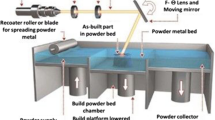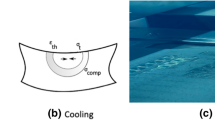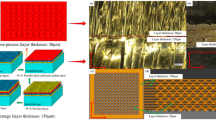Abstract
In a few last decades, equal-channel angular pressing (ECAP) has been one of the most prominent procedures for fabrication of ultrafine-grained (UFG) structures among various severe plastic deformation (SPD) techniques. The objective of this paper is to experimentally investigate the influence of longitudinal ultrasonic vibrations on the ECAP process. A robust experimental ECAP system was designed and manufactured, in which the punch can be excited by ultrasonic vibrations. ECAP experiments were carried out with and without ultrasonic vibration on pure Al. The microstructure of the specimens formed with ultrasonic-assisted ECAP and conventional ECAP were studied. The results of this study showed that superimposing ultrasonic vibrations on the ECAP process could improve the grain refinement efficiency. The grains of the specimens after conventional ECAP process were refined to 45 μm, while by applying ultrasonic vibration with amplitudes of 2.5 and 5 μm, the grains were refined to 28.2 and 22 μm , respectively. Using higher vibration amplitudes caused more refinement of the grains. The homogeneity of the microstructure after four passes of ECAP was also improved by 26.7 % while using ultrasonic vibration with amplitude of 2.5 μm. Higher vibration amplitudes made a more homogenous structure. The yield strength and ultimate tensile strength of the specimens after one pass of ECAP were higher in comparison with the conventional ECAP.
Similar content being viewed by others
References
Valiev RZ, Langdon TG (2006) Principles of equal-channel angular pressing as a processing tool for grain refinement. Prog Mater Sci 51(7):881–981
Valiev R, Mulyukov R, Ovchinnikov V, Shabashov V (1991) Mössbauer analysis of submicrometer grained iron. Scr Metall Mater 25(12):2717–2722
Salishchev GA, Imayev RM, Imayev V, Gabdullin N (1993) Dynamic recrystallization in TiAl and Ti3Al intermetallic compounds. In: Materials Science Forum. Trans Tech Publ, pp 613-618
Valiev RZ, Krasilnikov N, Tsenev N (1991) Plastic deformation of alloys with submicron-grained structure. Mater Sci Eng A 137:35–40
Segal V (1999) Equal channel angular extrusion: from macromechanics to structure formation. Mater Sci Eng A 271(1):322–333
Segal V (1995) Materials processing by simple shear. Mater Sci Eng A 197(2):157–164
Iwahashi Y, Horita Z, Nemoto M, Wang J, Langdon TG (1996) Principle of equal-channel angular pressing for the processing of ultra-fine grained materials. Scr Mater 35(2)
Dumoulin S, Roven H, Werenskiold J, Valberg H (2005) Finite element modeling of equal channel angular pressing: effect of material properties, friction and die geometry. Mater Sci Eng A 410:248–251
Djavanroodi F, Ebrahimi M (2010) Effect of die channel angle, friction and back pressure in the equal channel angular pressing using 3D finite element simulation. Mater Sci Eng A 527(4):1230–1235
Eivani A, Karimi Taheri A (2008) The effect of dead metal zone formation on strain and extrusion force during equal channel angular extrusion. Comput Mater Sci 42(1):14–20
Eivani A, Karimi Taheri A (2007) An upper bound solution of ECAE process with outer curved corner. J Mater Process Technol 182(1):555–563
Kanála N (2009) New geometry of ECAP channel. Acta Metall Slovaca 15(4):228–233
Fridman HD, Levesque P (2004) Reduction of static friction by sonic vibrations. J Appl Phys 30(10):1572–1575
Blaha F, Langenecker B (1955) Tensile deformation of zinc crystal under ultrasonic vibration. Naturwissenschaften 42:556
Pohlman R, Lehfeldt E (1966) Influence of ultrasonic vibration on metallic friction. Ultrasonics 4(4):178–185
Izumi O, Oyama K, Suzuki Y (1966) Effects of superimposed ultrasonic vibration on compressive deformation of metals. Jpn Inst Metals Trans 7(3):162–167
Winsper C, Sansome D (1969) Study of the mechanics of wire drawing with a superimposed ultrasonic stress. In: Proc 10th MTDR Conf, Advan in Mach Tool Des and Res, Manchester, England. pp 553-565
Young M, Winsper C, Sansome D (1970) The effect of tool attachment on the resonant characteristics of ultrasonic waveguides. Appl Acoust 3(3):217–224
Pasierb A, Wojnar A (1992) An experimental investigation of deep drawing and drawing processes of thin-walled products with utilization of ultrasonic vibrations. J Mater Process Technol 34(1):489–494
Cheers CF (1995) Design and optimisation of an ultrasonic die system for forming metal cans. Loughborough University
Littmann W, Storck H, Wallaschek J (2001) Reduction of friction using piezoelectrically excited ultrasonic vibrations. In: SPIE's 8th Annual International Symposium on Smart Structures and Materials, Newport Beach, California, United States of America. International Society for Optics and Photonics, pp 302-311
Kumar V, Hutchings I (2004) Reduction of the sliding friction of metals by the application of longitudinal or transverse ultrasonic vibration. Tribol Int 37(10):833–840
Bai Y, Yang M (2014) Influence of ultrasonic vibration on metal foils surface finishing with micro-forging. Procedia Engineering 81:1475–1480
Langenecker B (1966) Effects of ultrasound on deformation characteristics of metals. IEEE Trans Sonics Ultrason 13(1):1–8
Daud Y, Lucas M, Huang Z (2007) Modelling the effects of superimposed ultrasonic vibrations on tension and compression tests of aluminium. J Mater Process Technol 186(1):179–190
Schinke B, Malmberg T (1987) Dynamic tensile tests with superimposed ultrasonic oscillations for stainless steel type 321 at room temperature. Nucl Eng Des 100(3):281–296
Lucas M, Gachagan A, Cardoni A (2009) Research applications and opportunities in power ultrasonics. Proc Inst Mech Eng C J Mech Eng Sci 223(12):2949–2965
Malygin G (2000) Acoustoplastic effect and the stress superimposition mechanism. Phys Solid State 42(1):72–78
Hung J-C, Tsai Y-C, Hung C (2007) Frictional effect of ultrasonic-vibration on upsetting. Ultrasonics 46(3):277–284
Mousavi S, Feizi H, Madoliat R (2007) Investigations on the effects of ultrasonic vibrations in the extrusion process. J Mater Process Technol 187:657–661
Bunget C, Ngaile G (2011) Influence of ultrasonic vibration on micro-extrusion. Ultrasonics 51(5):606–616
Hung J-C, Huang C-C (2012) Evaluation of friction in ultrasonic vibration-assisted press forging using double cup extrusion tests. Int J Precis Eng Manuf 13(12):2103–2108
Hayashi M, Jin M, Thipprakmas S, Murakawa M, Hung J-C, Tsai Y-C, Hung C-H (2003) Simulation of ultrasonic-vibration drawing using the finite element method (FEM). J Mater Process Technol 140(1):30–35
Murakawa M, Jin M (2001) The utility of radially and ultrasonically vibrated dies in the wire drawing process. J Mater Process Technol 113(1):81–86
Suh C-M, Song G-H, Park H-D, Pyoun YS (2006) A study of the mechanical characteristics of ultrasonic cold forged SKD61. Int J Mod Phys B 20(25n27):4541–4546
Suh C-M, Song G-H, Suh M-S, Pyoun Y-S (2007) Fatigue and mechanical characteristics of nano-structured tool steel by ultrasonic cold forging technology. Mater Sci Eng A 443(1):101–106
Huang Y, Wu Y, Huang J (2014) The influence of ultrasonic vibration-assisted micro-deep drawing process. Int J Adv Manuf Technol 71(5–8):1455–1461
Rasoli M, Abdullah A, Farzin M, Tehrani AF, Taherizadeh A (2012) Influence of ultrasonic vibrations on tube spinning process. J Mater Process Technol 212(6):1443–1452
Hung J-C, Tsai Y-C (2013) Investigation of the effects of ultrasonic vibration-assisted micro-upsetting on brass. Mater Sci Eng A 580:125–132
Ahmadi F, Farzin M (2013) Finite element analysis of ultrasonic-assisted equal channel angular pressing. Proc Inst Mech Eng C J Mech Eng Sci 228(11):1859–1868. doi:10.1177/0954406213514961
Djavanroodi F, Ahmadian H, Koohkan K, Naseri R (2013) Ultrasonic assisted-ECAP. Ultrasonics 53(6):1089–1096
Rasooli M, Moshref-javadi M, Taherizadeh A (2014) Investigation of ultrasonic vibration effects on the microstructure and hardness of aluminum alloy 2024 tube spinning parts. The International J Adv Manuf Technol: 1-8. doi:10.1007/s00170-014-6500-5
Liu Y, Suslov S, Han Q, Xu C, Hua L (2012) Microstructure of the pure copper produced by upsetting with ultrasonic vibration. Mater Lett 67(1):52–55
Ting W, Dongpo W, Gang L, Baoming G, Ningxia S (2008) Investigations on the nanocrystallization of 40Cr using ultrasonic surface rolling processing. Appl Surf Sci 255(5):1824–1829
Faraji G, Ebrahimi M, Bushroa A (2014) Ultrasonic assisted tubular channel angular pressing process. Mater Sci Eng A
Liu Y, Suslov S, Han Q, Hua L, Xu C (2013) Comparison between ultrasonic vibration-assisted upsetting and conventional upsetting. Metall Mater Trans A 44(7):3232–3244
Liu Y, Han Q, Hua L, Xu C (2013) Numerical and experimental investigation of upsetting with ultrasonic vibration of pure copper cone tip. Ultrasonics 53(3):803–807
Peshkovsky SL, Peshkovsky AS (2007) Matching a transducer to water at cavitation: acoustic horn design principles. Ultrason Sonochem 14(3):314–322
AMMM generator manual (2011) www.mastersonics.com/
Ahmadi F, Farzin M (2014) Investigation of a new route for equal channel angular pressing process using three-dimensional finite element method. Proc Inst Mech Eng B J Eng Manuf 228(7):765–774. doi:10.1177/0954405413510309
Suo T, Li Y, Deng Q, Liu Y (2007) Optimal pressing route for continued equal channel angular pressing by finite element analysis. Mater Sci Eng A 466(1):166–171
Handbook A (2004) Metallography and microstructures. In: Vander Voort GF (ed) ASM Intenational 9
Handbook ASM (1992) Vol. 3. Alloy phase diagrams 2:44
Ensminger D, Stulen FB (2008) Ultrasonics: data, equations and their practical uses. CRC, Boca Raton
Lindsay RB (1960) Mechanical radiation. McGraw-Hill, New York
Westmacott K, Langenecker B (1965) Dislocation structure in ultrasonically irradiated aluminum. Phys Rev Lett 14(7):221
Mahallawy NE, Shehata FA, Hameed MAE, Aal MIAE, Kim HS (2010) 3D FEM simulations for the homogeneity of plastic deformation in Al–Cu alloys during ECAP. Mater Sci Eng A 527(6):1404–1410
Author information
Authors and Affiliations
Corresponding author
Rights and permissions
About this article
Cite this article
Ahmadi, F., Farzin, M., Meratian, M. et al. Improvement of ECAP process by imposing ultrasonic vibrations. Int J Adv Manuf Technol 79, 503–512 (2015). https://doi.org/10.1007/s00170-015-6848-1
Received:
Accepted:
Published:
Issue Date:
DOI: https://doi.org/10.1007/s00170-015-6848-1




